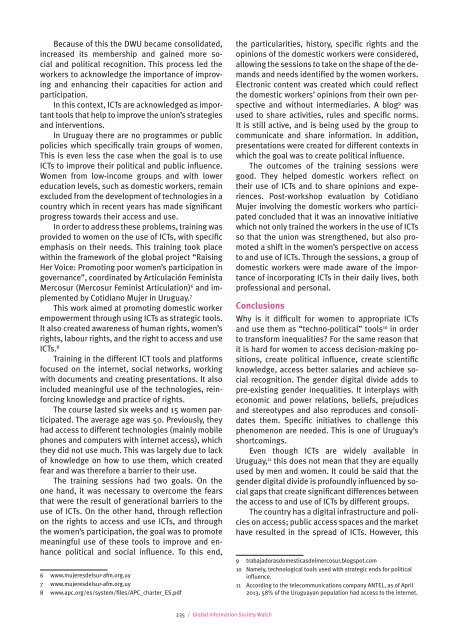gisw13_chapters
gisw13_chapters
gisw13_chapters
You also want an ePaper? Increase the reach of your titles
YUMPU automatically turns print PDFs into web optimized ePapers that Google loves.
Because of this the DWU became consolidated,increased its membership and gained more socialand political recognition. This process led theworkers to acknowledge the importance of improvingand enhancing their capacities for action andparticipation.In this context, ICTs are acknowledged as importanttools that help to improve the union’s strategiesand interventions.In Uruguay there are no programmes or publicpolicies which specifically train groups of women.This is even less the case when the goal is to useICTs to improve their political and public influence.Women from low-income groups and with lowereducation levels, such as domestic workers, remainexcluded from the development of technologies in acountry which in recent years has made significantprogress towards their access and use.In order to address these problems, training wasprovided to women on the use of ICTs, with specificemphasis on their needs. This training took placewithin the framework of the global project “RaisingHer Voice: Promoting poor women’s participation ingovernance”, coordinated by Articulación FeministaMercosur (Mercosur Feminist Articulation) 6 and implementedby Cotidiano Mujer in Uruguay. 7This work aimed at promoting domestic workerempowerment through using ICTs as strategic tools.It also created awareness of human rights, women’srights, labour rights, and the right to access and useICTs. 8Training in the different ICT tools and platformsfocused on the internet, social networks, workingwith documents and creating presentations. It alsoincluded meaningful use of the technologies, reinforcingknowledge and practice of rights.The course lasted six weeks and 15 women participated.The average age was 50. Previously, theyhad access to different technologies (mainly mobilephones and computers with internet access), whichthey did not use much. This was largely due to lackof knowledge on how to use them, which createdfear and was therefore a barrier to their use.The training sessions had two goals. On theone hand, it was necessary to overcome the fearsthat were the result of generational barriers to theuse of ICTs. On the other hand, through reflectionon the rights to access and use ICTs, and throughthe women’s participation, the goal was to promotemeaningful use of these tools to improve and enhancepolitical and social influence. To this end,6 www.mujeresdelsur-afm.org.uy7 www.mujeresdelsur-afm.org.uy8 www.apc.org/es/system/files/APC_charter_ES.pdfthe particularities, history, specific rights and theopinions of the domestic workers were considered,allowing the sessions to take on the shape of the demandsand needs identified by the women workers.Electronic content was created which could reflectthe domestic workers’ opinions from their own perspectiveand without intermediaries. A blog 9 wasused to share activities, rules and specific norms.It is still active, and is being used by the group tocommunicate and share information. In addition,presentations were created for different contexts inwhich the goal was to create political influence.The outcomes of the training sessions weregood. They helped domestic workers reflect ontheir use of ICTs and to share opinions and experiences.Post-workshop evaluation by CotidianoMujer involving the domestic workers who participatedconcluded that it was an innovative initiativewhich not only trained the workers in the use of ICTsso that the union was strengthened, but also promoteda shift in the women’s perspective on accessto and use of ICTs. Through the sessions, a group ofdomestic workers were made aware of the importanceof incorporating ICTs in their daily lives, bothprofessional and personal.ConclusionsWhy is it difficult for women to appropriate ICTsand use them as “techno-political” tools 10 in orderto transform inequalities? For the same reason thatit is hard for women to access decision-making positions,create political influence, create scientificknowledge, access better salaries and achieve socialrecognition. The gender digital divide adds topre-existing gender inequalities. It interplays witheconomic and power relations, beliefs, prejudicesand stereotypes and also reproduces and consolidatesthem. Specific initiatives to challenge thisphenomenon are needed. This is one of Uruguay’sshortcomings.Even though ICTs are widely available inUruguay, 11 this does not mean that they are equallyused by men and women. It could be said that thegender digital divide is profoundly influenced by socialgaps that create significant differences betweenthe access to and use of ICTs by different groups.The country has a digital infrastructure and policieson access; public access spaces and the markethave resulted in the spread of ICTs. However, this9 trabajadorasdomesticasdelmercosur.blogspot.com10 Namely, technological tools used with strategic ends for politicalinfluence.11 According to the telecommunications company ANTEL, as of April2013, 58% of the Uruguayan population had access to the internet.235 / Global Information Society Watch


